Did you know that over 7,000 species of frogs exist worldwide? These creatures showcase incredible diversity, from their vibrant colors to unique adaptations. This variety is largely driven by genetic differences, making them a fascinating subject for study.
One groundbreaking example is the 2016 creation of translucent frogs through selective breeding. This achievement highlights how genetic research can unlock new possibilities. Frogs are also critical model organisms in biomedical studies, helping scientists understand complex biological processes.
Their genetic diversity plays a vital role in survival, especially in changing environments. From poison dart frogs to red-eyed treefrogs, each species offers unique insights into evolution and adaptation. This guide explores how these traits shape the world of amphibians.
Key Takeaways
- Frogs exhibit remarkable diversity due to genetic variations.
- Selective breeding has led to unique discoveries, like translucent frogs.
- They are essential model organisms in biomedical research.
- Genetic diversity is crucial for species survival in changing environments.
- Studies on frogs provide insights into evolution and adaptation.
Introduction to Frog Morphs and Genetics
Frogs display a stunning array of colors and patterns, shaped by their unique genetic makeup. These physical traits, known as morphs, are heritable variations that can include differences in color, pattern, and size. For example, the red-eyed treefrog showcases vibrant hues that vary across its range.
What Are Frog Morphs?
Morphs are distinct physical variations within a species. A 2022 study in Costa Rica revealed that Agalychnis callidryas, the red-eyed treefrog, exhibits purple and orange morphs in specific regions. These differences are not just cosmetic; they are tied to specific genetic markers.
Unlike subspecies, morphs share the same genetic pool but express different traits. This is seen in the Japanese brown frog, where inheritance ratios follow a 9:3:3:1 pattern. Such studies highlight how genetics drive diversity.
The Importance of Genetics in Frog Diversity
Genetics play a crucial role in the survival of frog species. Chromatophores, specialized cells like xanthophores, iridophores, and melanophores, determine their coloration. For instance, glass frogs owe their transparency to these cells.
Genetic diversity also enhances ecosystem resilience. Amphibian decline statistics show that diverse populations adapt better to environmental changes. Research by Robertson on heritable color patterns in captive breeding further underscores this point.
| Chromatophore Type | Function | Example |
|---|---|---|
| Xanthophores | Produce yellow and red pigments | Red-eyed treefrog |
| Iridophores | Reflect light, creating iridescence | Glass frog |
| Melanophores | Produce dark pigments | Poison dart frog |
Understanding these genetic mechanisms helps scientists track environmental adaptation over time. From polytypic to polymorphic populations, frogs offer valuable insights into evolution and survival.
The Science Behind Frog Genetics
The study of genetics reveals fascinating insights into the traits of amphibians. Their genetic makeup determines everything from color patterns to survival mechanisms. This section explores the principles of genetics and how they shape these creatures.
Basic Genetic Principles in Frogs
Amphibians like Xenopus tropicalis have a diploid chromosome number of 10. Their genome contains 20,000-21,000 genes, similar to humans. This genetic complexity allows for diverse traits and adaptations.
Transposons, or “jumping genes,” make up 33% of the Xenopus genome. These elements play a role in genetic variation and evolution. Tools like RAD-seq analysis, using the Sbf1 restriction enzyme, help scientists study these patterns.
How Genes Influence Frog Morphology
Genes regulate key processes like metamorphosis. For example, chromatophore development is controlled by specific genetic markers. These cells determine coloration, from vibrant hues to transparency.
Pleiotropic effects, where one gene influences multiple traits, are common. The MHC gene system, shared between amphibians and humans, highlights this connection. Such similarities make them valuable for biomedical research.
Epigenetics also plays a role. Tadpoles adapt to environmental changes through gene regulation. This flexibility ensures survival in diverse habitats.
- Diploid chromosomes: Xenopus has 10 pairs.
- Genome size: 1.7 billion bases in Xenopus vs. 3 billion in humans.
- Gene neighborhood conservation: 85% similarity with humans.
Understanding Frog Morphs
The world of amphibians is filled with fascinating variations in appearance and behavior. These differences, known as morphs, are physical traits shaped by genetic and environmental factors. Morphs can include variations in color, pattern, and even size, making them a key area of study in biology.
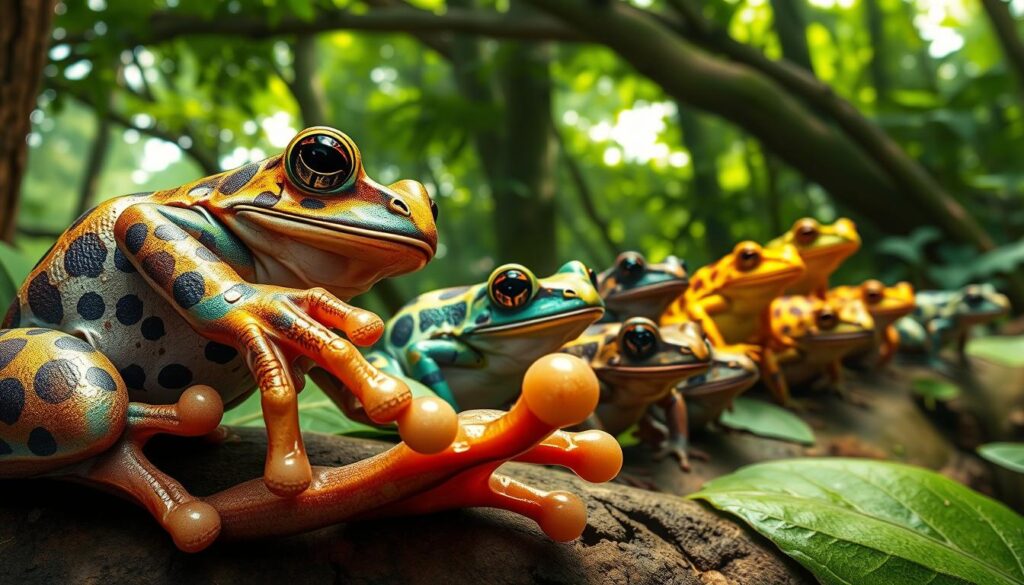
Defining Morphs in the Amphibian World
Morphs are distinct physical variations within a species. Unlike subspecies, they share the same genetic pool but express different traits. For example, the red-eyed treefrog exhibits purple and orange morphs in specific regions. These differences are tied to specific genetic markers, highlighting the role of genetics in diversity.
Common Types of Amphibian Morphs
Amphibians display a wide range of morphs, from color to pattern variations. In Central America, treefrogs exhibit four distinct color morphs: blue, red/blue, orange, and purple. These variations are not just cosmetic; they often serve specific functions, such as thermoregulation or camouflage.
High-altitude amphibians often have darker skin to absorb more heat, while aquatic species may have streamlined bodies for efficient swimming. Structural color, created by light reflection, differs from pigment-based coloration. For instance, the Japanese see-through frog lacks certain pigment cells, giving it a translucent appearance.
Polymorphic transition zones, like those in Pacific Costa Rican populations, show how morphs adapt to local environments. Industrial melanism, observed in historical studies, demonstrates how pollution can influence coloration. These examples underscore the importance of morphs in survival and adaptation.
Genetic Mutations and Frog Morphs
Genetic mutations play a pivotal role in shaping the diversity of amphibian traits. These changes in the genetic code can lead to new physical characteristics, from unique color patterns to specialized adaptations. Understanding how mutations work helps scientists uncover the secrets of amphibian diversity.
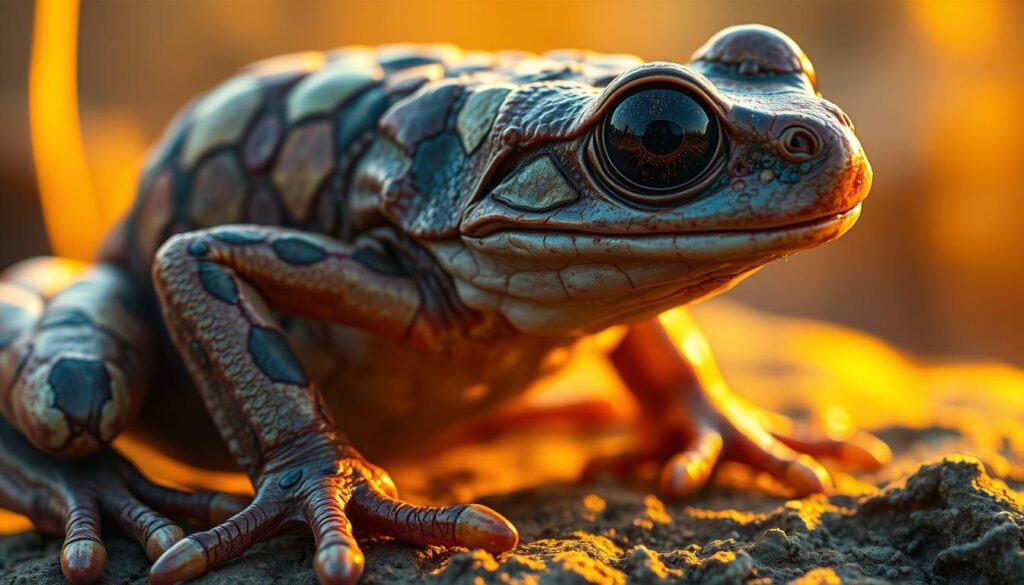
How Mutations Create New Traits
Mutations occur when there are changes in the DNA sequence. These changes can be small, like a single gene alteration, or large, affecting entire chromosomes. For example, recessive gene combinations can produce black or gray-eyed mutants in certain species.
CRISPR technology has revolutionized genetic research. Scientists now use it to edit specific genes, such as in Xenopus, to study their functions. This tool provides valuable data on how mutations influence traits.
Examples of Genetic Mutations
One groundbreaking example is the creation of see-through amphibians. In 2006, Hiroshima University patented a method to produce frogs with translucent skin. This innovation allows researchers to observe internal organs without dissection.
Albinism is another fascinating mutation. It occurs across Rana species due to a lack of pigment-producing cells. Hybrid amphibians often display chromatophore mosaicism, where cells with different pigments mix, creating unique patterns.
| Mutation Type | Example | Impact |
|---|---|---|
| Recessive Gene | Black-eyed mutants | Alters eye color |
| CRISPR Editing | Xenopus gene studies | Reveals gene functions |
| Albinism | Rana species | Lack of pigmentation |
| Temperature-Dependent | Sex reversal | Changes gender based on environment |
Temperature-dependent sex reversal is another intriguing mutation. In some species, the environment determines gender. This adaptation ensures survival in changing climates. The 9:3:3:1 segregation ratio, observed in Japanese breeding experiments, provides evidence of how traits are inherited.
Understanding these mutations helps scientists address challenges like inbreeding depression. By studying genetic diversity, they can develop strategies to protect endangered species.
Color Patterns in Frogs
Amphibians showcase a wide range of color patterns, each tied to unique biological processes. These patterns are not just visually striking but also serve critical survival functions. From bright reds to deep blues, the diversity of hues is a testament to their evolutionary adaptability.
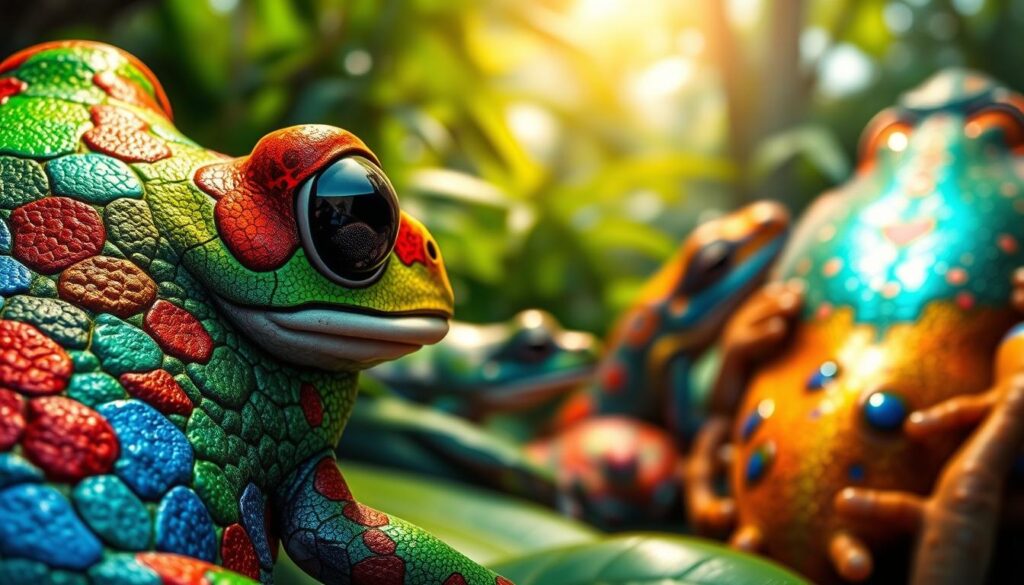
The Role of Chromatophores in Coloration
Specialized cells called chromatophores are responsible for the vibrant hues seen in many species. These cells are layered in the skin, with xanthophores at the top, iridophores in the middle, and melanophores at the base. Each layer plays a distinct role in creating the final color patterns.
For example, xanthophores produce yellow and red pigments, while iridophores reflect light to create iridescence. Melanophores, on the other hand, produce dark pigments. The interaction between these layers results in the stunning variety of hues observed in nature.
How Color Patterns Evolve Over Time
Evolutionary pressures, such as predator-driven selection, have shaped these patterns over millions of years. Aposematic species, which use bright colors to warn predators, are a prime example. Studies using reflectance spectroscopy have shown how these processes influence coloration.
The Pleistocene refugia hypothesis suggests that geographic isolation during ice ages led to the divergence of color traits. This is evident in species like the red-eyed treefrog, which exhibits non-sexual dimorphism in its skin patterns.
- Chromatophore layers: xanthophores, iridophores, melanophores.
- Pterinosome vs melanosome: organelles that store pigments.
- Hue-saturation-brightness PCA: a method to analyze color variation.
Rapid color change mechanisms, as seen in Phyllomedusinae, further highlight the adaptability of these species. By understanding these processes, scientists can uncover the secrets of amphibian evolution and survival.
Frog Morphs and Natural Selection
Natural selection plays a key role in shaping the traits of amphibian species. Over time, environmental pressures influence which characteristics become more common in a population. This process ensures that traits beneficial for survival and reproduction are passed on to future generations.
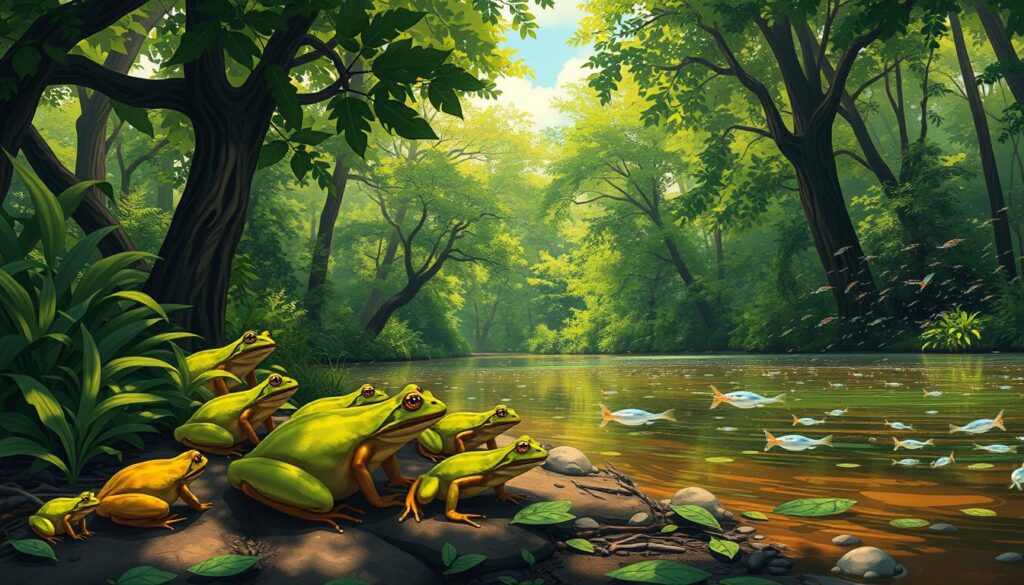
For example, certain morphs develop resistance to diseases like chytridiomycosis. Others adapt to high-altitude environments by developing darker skin for UV protection. These adaptations highlight the power of natural selection in driving diversity.
How Natural Selection Shapes Frog Morphs
Natural selection works through various mechanisms. One is frequency-dependent selection, where certain traits become advantageous based on their rarity. This is often seen in mimicry complexes, where less common patterns offer better protection.
Another mechanism is heterozygote advantage. In polymorphic populations, individuals with mixed traits often have higher survival rates. This ensures genetic diversity and resilience in changing environments.
Case Studies of Natural Selection in Frogs
In Costa Rica, studies have shown how transition zones maintain polymorphism. Different morphs thrive in specific habitats, ensuring their survival. This analysis provides insights into how populations adapt to local conditions.
High-altitude species often exhibit darker skin to absorb more UV radiation. This adaptation protects them from harmful rays, showcasing how environmental factors shape traits.
| Mechanism | Example | Impact |
|---|---|---|
| Frequency-Dependent Selection | Mimicry complexes | Protection through rarity |
| Heterozygote Advantage | Polymorphic populations | Increased survival rates |
| UV Protection | High-altitude species | Darker skin for radiation absorption |
| Chytrid Resistance | Certain morphs | Disease survival |
Climate change is also influencing morph distribution. As habitats shift, certain traits become more advantageous. Understanding these processes helps scientists predict how species will adapt in the future.
Research on Frog Morphs and Genetics
Scientific advancements have unlocked new insights into the genetic makeup of amphibians. These discoveries highlight the importance of research in understanding their diversity and survival mechanisms. From groundbreaking studies to innovative techniques, the field continues to evolve.

Key Studies on Amphibian Genetics
One notable study from 2016 involved the creation of translucent amphibians through selective breeding. This PMC free article demonstrated how genetic manipulation can reveal internal processes without invasive methods. Such breakthroughs pave the way for future discoveries.
Another significant project used RAD-seq protocols to analyze genetic diversity in Costa Rican populations. This research provided valuable data on how environmental factors influence genetic traits. These findings are crucial for conservation efforts.
Recent Advances in Amphibian Genetic Research
Recent advancements include the use of CRISPR-Cas9 for gene knockout experiments. This technique allows scientists to study specific genes and their functions. For example, the Xenopus genome has been mapped, revealing 1,700 human disease homologs.
Environmental DNA (eDNA) monitoring is another innovative approach. It enables researchers to track species presence without direct observation. Additionally, HiSeq4000 sequencing provides detailed data on genetic variations, including 150bp paired-end reads.
- Transposon mobility impacts gene regulation, offering insights into evolutionary processes.
- The NIH-funded Xenopus Resource Center supports ongoing research.
- Proteomic approaches help characterize morphs at the molecular level.
These advancements underscore the importance of genetic study in understanding amphibian diversity. By leveraging cutting-edge tools, scientists can address challenges like habitat loss and climate change.
The Role of Frogs in Genetic Research
Amphibians have become essential tools in advancing genetic research. Their unique biological traits make them ideal for studying complex processes. From embryology to disease modeling, these creatures provide valuable insights into genetics and human health.

Why Amphibians Are Important Model Organisms
Amphibians, particularly Xenopus species, are widely used as model organisms. Their external fertilization allows researchers to observe developmental stages in real time. This function is crucial for embryology studies, providing a clear view of early cell division and organ formation.
Another advantage is their rapid metamorphosis, which is driven by thyroid hormones. This process offers a unique opportunity to study gene regulation and tissue remodeling. Such research has led to discoveries in human developmental biology and endocrinology.
Contributions of Amphibian Research to Genetics
Amphibian studies have contributed significantly to our understanding of genetic systems. For example, the Xenopus genome contains over 200 human disease gene homologs. This information helps scientists study conditions like cancer and immune disorders.
Limb regeneration research in Xenopus has also provided insights into tissue repair and stem cell activity. These findings could lead to breakthroughs in regenerative medicine. Additionally, Nobel-winning studies on cell cycle regulation used amphibian eggs to uncover fundamental biological principles.
“Amphibians offer a unique window into the genetic mechanisms that drive life.”
| Research Area | Contribution |
|---|---|
| Embryology | External fertilization allows real-time observation of development. |
| Disease Modeling | 200+ human disease gene homologs identified in Xenopus. |
| Regenerative Medicine | Limb regeneration studies provide insights into tissue repair. |
| Cell Cycle Research | Nobel-winning discoveries using amphibian eggs. |
Recent advancements include optogenetics, where amphibian neurons are used to study brain activity. Organoid development using amphibian cell cultures is another exciting area. These innovations highlight the ongoing importance of amphibians in genetic research.
Frog Morphs and Environmental Adaptation
Amphibians have evolved unique traits to thrive in diverse environments. Their ability to adapt to different conditions is a testament to their resilience. From high-altitude mountains to dense rainforests, these creatures showcase remarkable versatility.
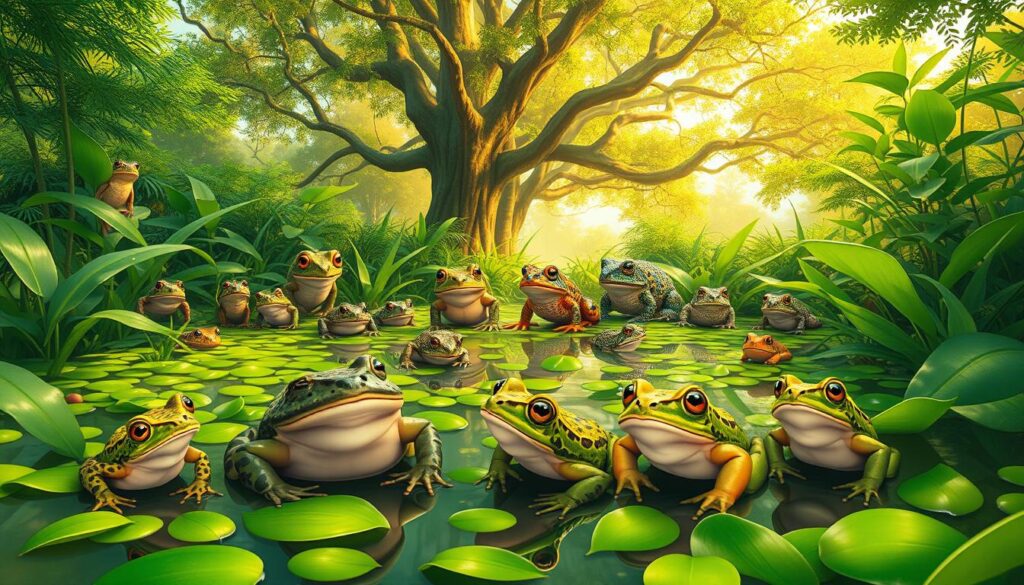
How Frogs Adapt to Different Environments
Amphibians exhibit a range of adaptations to survive in various habitats. For example, Andean species develop darker skin to absorb more UV radiation at high altitudes. This adaptation, known as altitudinal melanism, helps them regulate body temperature in colder climates.
In the Amazon, some species change color based on pH levels in their environment. This sensitivity allows them to blend into their surroundings, avoiding predators. Desert-dwelling amphibians, on the other hand, have evolved water retention mechanisms to survive in arid conditions.
Boreal chorus frogs can tolerate freezing temperatures by producing antifreeze proteins. This adaptation ensures their survival in harsh winter environments. These processes highlight the incredible adaptability of amphibians.
The Impact of Environment on Frog Morphs
Environmental factors significantly influence the traits of amphibians. For instance, poison frogs form Müllerian mimicry rings, where different species share similar warning patterns. This strategy deters predators by signaling toxicity.
A 2020 study revealed that pesticides can induce changes in amphibian traits. Urban environments also shape adaptations, with some species developing concrete-colored skin to blend into cityscapes. Cave-dwelling amphibians trade visual senses for enhanced hearing and touch, adapting to dark habitats.
Metabolic rates vary between morphs, influencing their energy use and survival. These adaptations ensure that amphibians can thrive in their specific environments.
| Adaptation | Environment | Example |
|---|---|---|
| Altitudinal Melanism | High-altitude mountains | Andean species |
| pH-Sensitive Coloration | Amazon rainforest | Amazonian species |
| Water Retention | Deserts | Desert-dwelling amphibians |
| Freeze Tolerance | Boreal regions | Boreal chorus frogs |
Understanding these adaptations helps scientists predict how amphibians will respond to environmental changes. From mimicry rings to urban camouflage, these traits are vital for their survival.
Genetic Diversity in Frog Populations
Genetic diversity is a cornerstone of survival for many species, offering resilience against environmental changes. In amphibian populations, this diversity ensures adaptability to shifting habitats and emerging threats. Understanding the factors that influence genetic variation is key to conservation efforts.
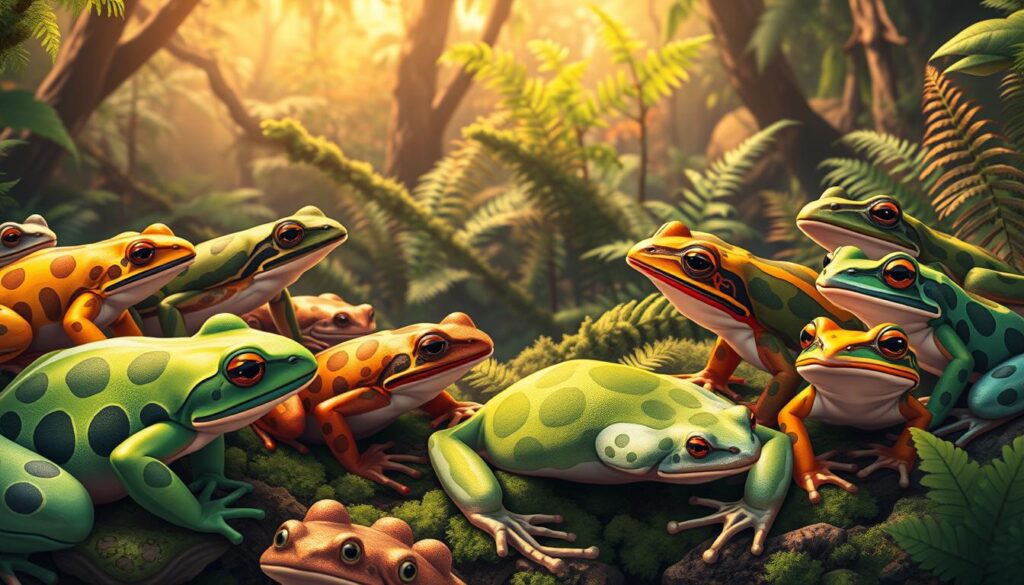
Factors Influencing Genetic Diversity
Several factors shape the genetic makeup of amphibian populations. Founder effects, for instance, occur when a small group establishes a new population, leading to reduced genetic variation. Island populations often exhibit this phenomenon, as seen in studies analyzing loci diversity.
Environmental variables also play a significant role. A 2013 analysis revealed that water and temperature conditions correlate with genetic variation. Central populations tend to have higher genic diversity compared to isolated ones, highlighting the impact of habitat connectivity.
Mutation-selection balance is another critical factor. While mutations introduce new genes, natural selection filters out harmful traits. This balance ensures that beneficial variations persist, enhancing population resilience.
The Importance of Genetic Diversity in Frogs
Genetic diversity is vital for species survival. It allows populations to adapt to challenges like disease outbreaks and climate change. For example, some amphibians exhibit resistance to chytridiomycosis, a deadly fungal infection, due to their diverse genetic makeup.
Heterozygosity-fitness correlations further underscore this importance. Individuals with mixed genes often have higher survival rates, as seen in studies using FST statistics. This diversity ensures that populations remain robust in the face of environmental pressures.
“Genetic variation is the foundation of adaptability, enabling species to thrive in ever-changing ecosystems.”
Landscape genetics approaches provide valuable insights into these processes. By examining gene flow and allele frequencies, scientists can identify patterns that support conservation strategies. For instance, the presence of 213 private alleles in the Bijagual site highlights unique genetic traits worth preserving.
- Effective population size calculations reveal the genetic health of populations.
- Founder effects reduce diversity in isolated groups.
- Chytrid-driven bottlenecks underscore the need for genetic resilience.
- Gene flow analysis using FST statistics tracks population connectivity.
Understanding these dynamics helps scientists address challenges like habitat loss and climate change. By leveraging evidence from genetic studies, conservation efforts can be tailored to protect vulnerable species.
For more on genetic variation, visit this detailed study.
Frog Morphs and Hybridization
Hybridization in amphibians reveals fascinating insights into genetic diversity. This process occurs when two distinct species interbreed, producing offspring with unique traits. Unlike introgression, which involves gene flow between hybrid and parent populations, hybridization creates entirely new genetic combinations.

What Is Hybridization in Frogs?
Hybridization is a natural phenomenon that bridges the gap between different amphibian groups. For example, the European water frog complex includes hybrids like Pelophylax esculentus, which result from the interbreeding of two parent species. These hybrids often exhibit traits from both parents, creating a unique blend of characteristics.
Haldane’s rule, which states that hybrid offspring of one sex are often sterile, applies to many amphibian hybrids. This rule explains why certain hybrids, like those in the Caribbean contact zone, struggle to reproduce. Gamete compatibility experiments further highlight the challenges of hybrid viability.
Examples of Hybridization in Frog Species
A 2020 study analyzed hybridization in Caribbean amphibians, revealing distinct patterns in transition zones. The study found that hybrids often display nuclear-mitochondrial discordance, where genetic material from one parent dominates. This phenomenon provides valuable data on how hybridization shapes evolution.
Another example is the 3:3:1:1 segregation ratio observed in hybrid offspring. This ratio indicates how traits are inherited, offering insights into genetic mechanisms. However, not all hybridization attempts succeed. Eight failed F1 hybrid rearing attempts highlight the complexities of hybrid survival.
| Hybrid Example | Parent Species | Key Findings |
|---|---|---|
| Pelophylax esculentus | Pelophylax lessonae & Pelophylax ridibundus | Exhibits traits from both parents, often fertile. |
| Caribbean Contact Zone Hybrids | Various Caribbean species | Nuclear-mitochondrial discordance observed. |
| Failed F1 Hybrids | Multiple species | Eight attempts failed due to viability issues. |
Hybrid zone maintenance theories suggest that environmental factors and Wolbachia infections influence hybrid viability. These theories are supported by studies referenced in this article, which analyze how hybridization impacts amphibian populations.
Frog Morphs and Conservation
Conservation efforts for amphibians are increasingly relying on genetic insights to protect vulnerable species. Morphs, or distinct physical variations, play a crucial role in these efforts. Understanding how these traits influence survival helps scientists develop targeted strategies to combat threats like habitat loss and disease.
The Role of Morphs in Frog Conservation
Morph-specific traits can determine how well a species adapts to environmental changes. For example, certain morphs show higher resistance to diseases like chytridiomycosis. This fungal infection has caused significant declines in amphibian populations worldwide. By studying these variations, researchers can identify which morphs are more likely to survive in changing conditions.
Habitat corridors are another key focus. These pathways connect fragmented habitats, allowing for genetic exchange between populations. This connectivity enhances genetic diversity, making species more resilient to threats. A 2021 study highlighted the success of such corridors in preserving harlequin frogs, which face a 6.7% annual decline.
How Genetics Can Help Save Endangered Frogs
Genetic rescue strategies are emerging as a powerful tool in conservation. One approach involves editing genes to create chytrid-resistant individuals. In 2021, scientists successfully used CRISPR technology to introduce resistance in a lab setting. This breakthrough offers hope for species on the brink of extinction.
Biobanking is another innovative solution. Cryopreserved gametes from endangered species are stored for future use. This ensures that genetic material is available for breeding programs, even if wild populations decline. Ex situ breeding programs, which take place outside natural habitats, also rely on genetic diversity to produce healthy offspring.
“Genetic diversity is the key to ensuring the survival of endangered species in a rapidly changing world.”
Environmental DNA (eDNA) monitoring is transforming conservation research. This method detects species presence through genetic material in water or soil. It allows scientists to track populations without disturbing their habitats. Such activity is vital for monitoring species listed on IUCN’s Evolutionary Distinct Species list.
- Morph-specific disease susceptibility influences survival rates.
- Genetic rescue strategies include chytrid-resistant gene editing.
- Biobanking preserves genetic material for future use.
- Habitat corridors enhance genetic connectivity.
- eDNA monitoring tracks species without direct observation.
By leveraging genetic insights, conservationists can develop more effective strategies to protect endangered amphibians. From gene editing to habitat restoration, these efforts are crucial for preserving biodiversity in the face of climate change and other threats.
Practical Applications of Frog Genetics
The genetic makeup of amphibians offers practical solutions in both medicine and environmental science. These creatures provide unique insights into complex biological processes, making them invaluable for research and innovation.
Using Amphibian Genetics in Medicine
Amphibians, particularly Xenopus species, are widely used in medical research. Their oocyte expression systems allow scientists to study gene functions and human disease homologs. For example, over 1,700 human disease genes have counterparts in the Xenopus genome.
Organogenesis studies using these species have led to breakthroughs in understanding tissue development. Thyroid disruption chemical testing is another critical application, helping researchers assess the safety of environmental toxins.
Nobel-winning IVF techniques were developed using amphibian eggs, showcasing their importance in reproductive medicine. These findings highlight how amphibian genetics contribute to medical advancements.
Amphibian Genetics in Environmental Science
In environmental science, amphibians serve as biosensors for monitoring ecosystem health. Tadpole assays are used to test water quality and detect pollutants. This function helps scientists identify environmental risks and develop mitigation strategies.
Antibiotic peptide discovery is another area where amphibian genetics play a role. Their skin secretions contain compounds with potential medical applications. Paleoclimate reconstruction using amphibian DNA provides valuable information on historical environmental changes.
| Application | Field | Impact |
|---|---|---|
| Oocyte Expression Systems | Medicine | Study of gene functions and disease homologs. |
| Thyroid Disruption Testing | Medicine | Assess safety of environmental toxins. |
| Tadpole Assays | Environmental Science | Monitor water quality and detect pollutants. |
| Antibiotic Peptide Discovery | Medicine | Identify compounds with medical potential. |
| Paleoclimate Reconstruction | Environmental Science | Understand historical environmental changes. |
These applications demonstrate the versatility of amphibian genetics. From medical breakthroughs to environmental monitoring, their contributions are shaping the future of science.
Future Directions in Frog Genetics Research
The future of amphibian genetic studies is brimming with innovative possibilities. From advanced sequencing techniques to groundbreaking applications of AI, the field is evolving rapidly. These advancements promise to unlock new insights into the genome and its role in shaping diverse traits.
Emerging Technologies in Amphibian Genetics
Single-cell sequencing is revolutionizing how scientists analyze genetic data. This technology allows researchers to study individual cells, providing unprecedented detail about gene expression and cellular functions. Another breakthrough is CRISPR prime editing, which offers more precise genetic modifications than traditional CRISPR methods.
AI-based morph recognition is also transforming the field. By analyzing patterns in physical traits, AI can identify subtle variations that might be missed by the human eye. These tools are particularly useful for studying species with complex morphologies.
What the Future Holds for Amphibian Morph Research
The 2025 Anuran Genome Project aims to sequence the complete genome of multiple species. This initiative will provide a comprehensive resource for studying genetic diversity and evolution. Multi-omics integration, which combines data from genomics, proteomics, and metabolomics, will further enhance our understanding of amphibian biology.
Citizen science monitoring apps are empowering the public to contribute to research. These apps allow users to document sightings and upload photos, creating a vast database for scientists to analyze. Synthetic chromosome engineering is another exciting frontier, with potential applications in conservation and de-extinction efforts.
“The integration of cutting-edge technologies is transforming how we study and protect amphibian species.”
Climate modeling integration is helping scientists predict how species will adapt to environmental changes. Space biology experiments are also exploring how amphibians respond to microgravity, offering insights into their resilience and adaptability.
| Technology | Application |
|---|---|
| Single-Cell Sequencing | Detailed analysis of gene expression at the cellular level. |
| CRISPR Prime Editing | Precise genetic modifications for targeted traits. |
| AI-Based Morph Recognition | Identification of subtle physical variations. |
| 2025 Anuran Genome Project | Comprehensive sequencing of multiple species. |
| Multi-Omics Integration | Combined analysis of genomics, proteomics, and metabolomics. |
These advancements are not just theoretical; they are already shaping the future of amphibian research. By leveraging these tools, scientists can address pressing challenges like habitat loss and climate change, ensuring the survival of these vital species.
Conclusion: The Fascinating World of Frog Morphs and Genetics
Exploring the genetic diversity of amphibians reveals a world of endless possibilities. From understanding how genes shape unique traits to unlocking medical breakthroughs, these creatures continue to inspire research. Their role as a model in scientific study has led to discoveries that benefit both humans and ecosystems.
Conservation efforts are more urgent than ever. With many frogs facing habitat loss and disease, protecting their genetic diversity is crucial. Transition zones and habitat corridors play a vital role in ensuring their survival.
Looking ahead, emerging technologies like CRISPR and AI promise to revolutionize this field. Public engagement is also key—everyone can contribute to conservation efforts. Together, we can ensure these fascinating creatures thrive for generations to come.
FAQ
What are frog morphs?
Why are genetics important in frog diversity?
How do genes influence frog morphology?
What are chromatophores, and how do they affect frog coloration?
How does natural selection shape frog morphs?
Why are frogs used as model organisms in genetic research?
How do frogs adapt to different environments?
What is hybridization in frogs?
How can genetics help in frog conservation?
What are the future directions in frog genetics research?

I’m Lena Adams—a product of an unconventional upbringing in the African wilderness. My father, a daring explorer of African wildlife, sparked my fascination with reptiles, a passion that intertwined with the tragic loss of my mother during an expedition, leaving an indelible mark on my life. Driven to understand the creatures that captivated my parents, I embarked on my journey, sharing insights about reptiles, frogs, and lizards on my website. Through my explorations and conservation efforts, I honour my family’s legacy while seeking connections—to the creatures, nature, and the mother whose presence I yearn to understand.
